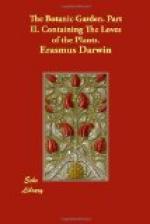Where the passions are introduced, as the Poet, on one hand, has the power gradually to prepare the mind of his reader by previous climacteric circumstances; the Painter, on the other hand, can throw stronger illumination and distinctness on the principal moment or catastrophe of the action; besides the advantage he has in using an universal language, which can be read in an instant of time. Thus where a great number of figures are all seen together, supporting or contrasting each other, and contributing to explain or aggrandize the principal effect, we view a picture with agreeable surprize, and contemplate it with unceasing admiration. In the representation of the sacrifice of Jephtha’s Daughter, a print done from a painting of Ant. Coypel, at one glance of the eye we read all the interesting passages of the last act of a well-written tragedy; so much poetry is there condensed into a moment of time.
B. Will you now oblige me with an account of the relationship between Poetry, and her other sister, Music? P. In the poetry of our language I don’t think we are to look for any thing analogous to the notes of the gamut; for, except perhaps in a few exclamations or interrogations, we are at liberty to raise or sink our voice an octave or two at pleasure, without altering the sense of the words. Hence, if either poetry or prose be read in melodious tones of voice, as is done in recitativo, or in chaunting, it must depend on the speaker, not on the writer: for though words may be selected which are less harsh than others, that is, which have fewer sudden stops or abrupt consonants amongst the vowels, or with fewer sibilant letters, yet this does not constitute melody, which consists of agreeable successions of notes referrable to the gamut; or harmony, which consists of agreeable combinations of them. If the Chinese language has many words of similar articulation, which yet signify different ideas, when spoken in a higher or lower musical note, as some travellers affirm, it must be capable of much finer effect, in respect to the audible part of poetry, than any language we are acquainted with.
There is however another affinity, in which poetry and music more nearly resemble each other than has generally been understood, and that is in their measure or time. There are but two kinds of time acknowledged in modern music, which are called triple time, and common time. The former of these is divided by bars, each bar containing three crotchets, or a proportional number of their subdivisions into quavers and semiquavers. This kind of time is analogous to the measure of our heroic or iambic verse. Thus the two following couplets are each of them divided into five bars of triple time, each bar consisting of two crotchets and two quavers; nor can they be divided into bars analogous to common time without the bars interfering with some of the crotchets, so as to divide them.




